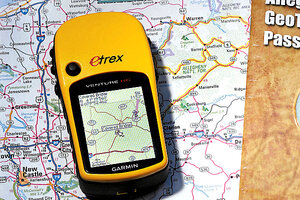Which is bigger: California or Los Angeles? Most fourth graders aren't sure.
Geography results from the National Report Card show that few students have a 'proficient' understanding of geography, as reading and math push social sciences out of the classroom.

Map-reading is becoming a 'lost art,' says Shannon Garrison, a fourth-grade teacher and a member of the National Assessment Governing Board, after reviewing the geography results from the nation's report card.
Photo illustration: Christopher Millette / Erie Times-News / AP
Few US students demonstrate mastery of geography, despite some small gains for fourth-graders and some gaps between white and minority students narrowing slightly.
The National Assessment of Education Progress (NAEP), also known as the Nation’s Report Card, released its third and final social studies report this year, and the results closely mirror the civics and history results that came out in prior months.
In all three subjects, fourth-graders have made some gains, while scores for older kids have stagnated or even declined slightly. And in all three, only a small minority of students achieved a level deemed “proficient” – and just a miniscule handful qualified as “advanced.”
“To the extent … that classroom time becomes an even more precious and scarce commodity, geography, with subjects such as history and the arts, is losing out in the zero-sum game that results from high-stakes testing,” said Roger Downs, a geography professor at Pennsylvania State University, in a statement.
The geography test tries to assess students’ knowledge not just of places and names, but also the relationships between people and the land.
Just over half of fourth-graders knew that farming – as opposed to fishing, mining, or recreation – is the most common land use in the Midwest, for instance. And just 4 percent of eighth graders were able to explain a graph showing urban and rural population changes over time (26 percent gave a partial response).
Even the good news from the report – the rising scores at the fourth-grade level – is mixed. Yes, fourth-graders scored 5 points higher (on a 500-point scale) in 2010 than in 2001, and 7 points higher than in 1994. But the change was solely due to students at the lowest achievement levels moving up. More students reached the “basic” level than in the previous two years, but there was no change in the number of "proficient" students, and the percentage of "advanced" students – just 2 percent of fourth-graders – was actually lower than in 1994.
“These improvements may all reflect another trend in NAEP, the gain in basic reading skills,” noted fourth-grade teacher and National Assessment Governing Board member Shannon Garrison, in a statement on the results. “The improvement in basic reading skills would certainly impact the lower-performing students, since if they can read the questions easily, they have a much better chance of answering them correctly. However, to reach ‘proficient’ requires more detailed knowledge of geography and critical thinking skills.”
In terms of achievement gaps, the geography exam showed some small improvements at the lower grades, but no changes for 12th graders. The white-black gap has narrowed since 1994 and 2001 for both fourth- and eighth-graders, and the white-Hispanic gap narrowed for fourth-graders. Boys also scored several points higher than girls at all three grade levels, with no change from prior years.
And if the results for fourth-graders – which show the most improvement in almost all NAEP subjects – are somewhat promising, the results for 12th graders are decidedly discouraging. Just 20 percent of 12th graders performed at the proficient level in 2010, compared with 25 percent in 2001 and 27 percent in 1994. Just 1 percent reached advanced.
To reach proficiency, high school seniors need to be able to interpret maps, discuss physical and cultural features of major world regions, and discuss economic, political, and social factors that define different areas, notes Ms. Garrison. “Yes, the proficient standard is challenging, but it is one that students need to reach in order to understand our complex world.”
Garrison also lamented the fact that reading a map seems to be turning into a “lost art,” and that just 51 percent of fourth-graders could list in descending order of size North America, the USA, California, and Los Angeles.
“The basic skills are important,” Garrison said, “but our schools must go beyond that to develop the insights and analytical abilities that our students need to understand the world.”
She and Professor Downs also lamented the lack of emphasis placed on social sciences by schools, even as globalization makes such knowledge more important.
“While geography begins with place location knowledge, the focus on understanding relationships between people and their environment is increasingly crucial in a world in which the local is connected to the global, and global events affect local places,” Downs said. “And yet geography’s role in the curriculum is limited and, at best, static.”
